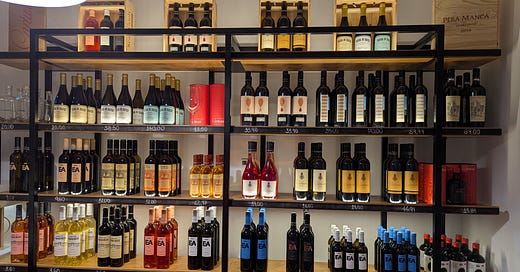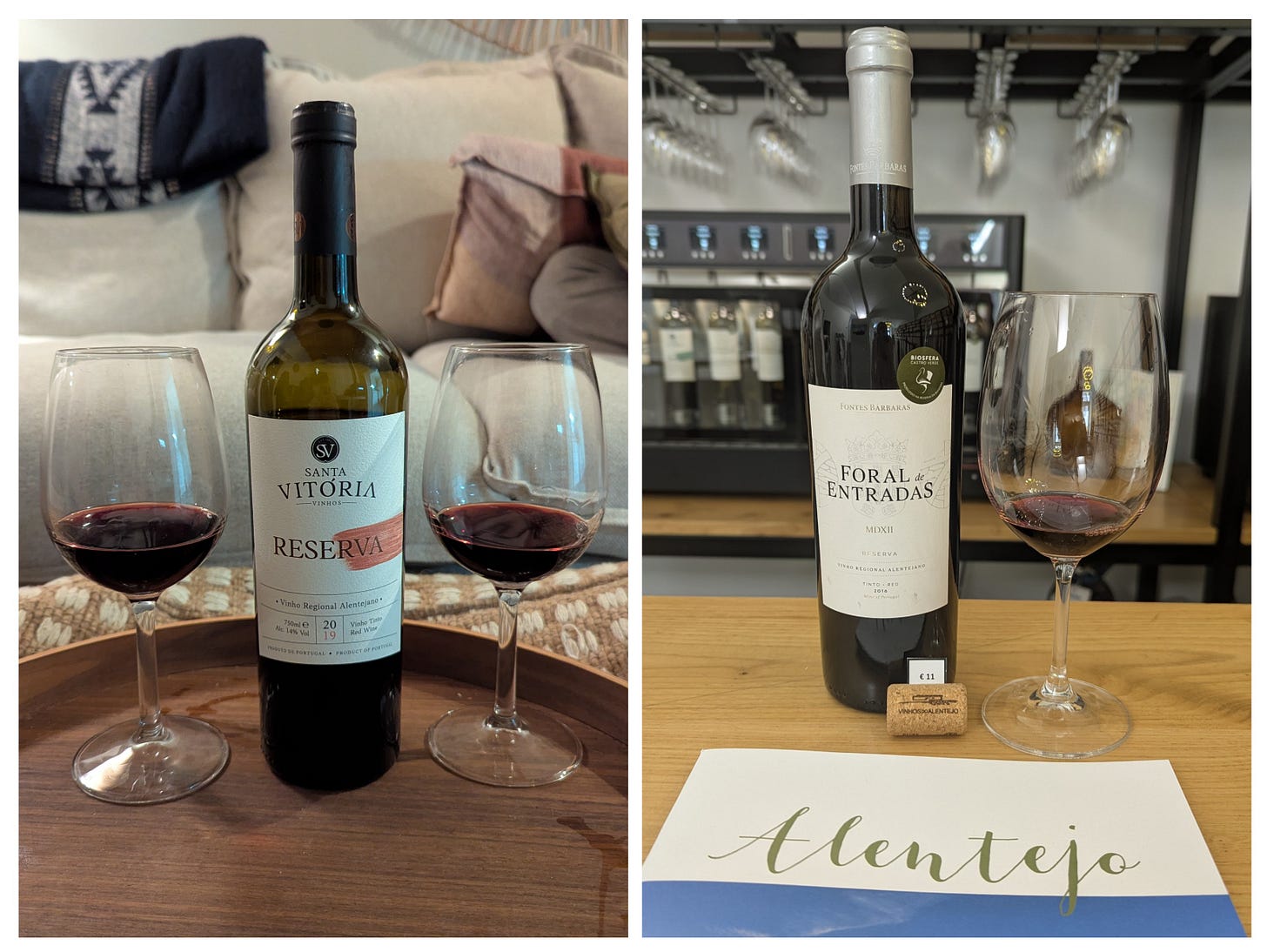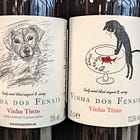This is part 2 of my guide to Portugal’s Alentejo wine region. If you missed part 1, you can catch up here!
Alentejo Wine Guide Part 1: Winery Visits
While the Douro Valley might win Portugal’s prize for Most Majestic Wine Region, Alentejo has a quiet, understated charm that rewards those who take the time to get to know it. The landscape is open and undulating, with cork trees everywhere and vines growing over 250 native grape varieties (Portugal is second only to Italy in terms of its number of native grapes). The region is mostly hot and dry (supposedly – not much evidence of that these past few weeks!), which no doubt helps out with many wineries’ sustainability ambitions to produce more organic and biodynamic bottles.
Wine tasting in Évora
Visiting Évora, it’s clear that wine is taken seriously: the Évorans (if that’s a word) are proud to show off their region’s glorious grapes. Which is perhaps why there’s a lot of crossover between the city’s wine businesses: shops that offer tastings, bars that also let you buy wine to take home, museums dedicated to wine – you name it.
Rota dos Vinhos do Alentejo
The Comissão Vitivinícola Regional Alentejana (CVRA – or the Alentejo Regional Winegrowing Commission in English) was founded in 1989 to certify, control and protect the Alentejo DOC and vinho regional wines. It also has its own tasting room and interpretation centre (a small museum, effectively) in Évora, which is my absolute top tip for visiting wine lovers. Monday through Saturday, Rota dos Vinhos offers guided tastings every half hour or so – starting with some general information about the Alentejo region and then pouring four wines from some of the 275 wineries that the CVRA represents. Each week, the selection of wines available to taste changes, which means that if you’re in Évora for longer than a week you can go back and get an entirely different tasting. And all for €5 per person!
If you’re so minded, seek out my personal favourites that I tasted at Rota dos Vinhos: the 2019 Santa Vitória Reserva, and the 2016 Foral de Entradas Reserva (pictured above) – both red blends that had spent considerable time in oak, leading to stewed prunes and wet forest floor in the case of the first, and floral violets and black cherries in the case of the second.
Louro Wines
Louro’s is a proper old-school wine shop that looks like it’s from a Dickensian novel; the cash till and service area are behind a sort of post office counter, beyond which wooden wine boxes are piled high. I’m not sure whether the owner organises any tastings, but do pop in to have a chat with him (he’s very knowledgeable) and pick up a bottle to take home. Although the selection is small, it’s well curated: selling everything from a €12 fruity Alentejan rosé to the fearsomely expensive, and rather intimidating, Pêra-Manca by Cartuxa – a limited edition wine that’s only produced in exceptional vintages.
TascaTosca & Wine Restaurant
We found TascaTosca on our very first evening in Evora, while looking for somewhere we could sit outside with our dog (it was 12 degrees and damp, but we couldn’t leave the dog home alone on her first night). Then we saw the magic blue sign, whose words we couldn’t understand but whose symbol we could: dogs allowed! Fortunately, good wine was also permitted: the peppery 2019 Petit Verdot Reserva from Dona Maria (a winery in nearby Estremoz) was an ideal start to a chilly evening and the next installment of our 2025 nomading adventure.
Enoteca Cartuxa
As I mentioned in part 1, you can pop into Enoteca Cartuxa in the city centre if you don’t have the time or inclination to head out to the neighbouring winery. Almost all of Cartuxa’s wines (from their entry level Monte de Pinheiros and EA labels to their premium Cartuxa and Scala Coeli labels) are available by the glass as well as by the bottle, enabling you to try a range of different styles and price points at the bar.
Ervideira Wine Shop
Similar to Cartuxa, Monsaraz-based winery Evideira has a wine shop and tasting room in the centre of Évora’s old town. For €10, you get to taste five wines – including their award-winning white “Conde d’Ervideira Reserva”, lake-aged red “Vinho da Agua”, and fortified “Tinta Calada” that tastes like a smart tawny port. Everything you try is available to buy, and you’re sure to walk out with at least a bottle or two.
Courelas da Torre
Just off Évora’s main square, Courelas da Torre looks like a general natural wine bar, but in fact exclusively sells wines from its own estate on the outskirts of Redondo. The quality can be a little hit and miss: I enjoyed their peachy “Luminoso” orange wine, but their plummy “Felisbela” rosé turned mousy within minutes. A shame because it showed promise.
Other Alentejo wines to look out for
I had a whole list of wineries I was keen to visit, but needless to say, time ran out before I could get to most of them. So instead, I made a point of seeking out their wines on restaurant menus. The bottles below weren’t part of any formal tasting or tour – just wines I drank with dinner and thought deserved a mention.
Incidentally, if you’re interested in Alentejo’s cuisine as well as its wines, read my guide to Évora restaurants over on my other website.
Herdade do Sobroso (2021 Cellar Selection red) – A beautifully balanced Alicante Bouschet-Syrah red blend with enough acidity and body to stand up to hearty Alentejan food. Aged for 12 months in French oak and classified as DOC Alentejo.
Herdade do Cebolal (2021 Clarete) – A natural, biodynamic wine from the coastal part of Alentejo close to Setúbal, made from 100% Castelão. Light, floral and saline, with leafy notes and bright, refreshing acidity.
Cortes de Cima (2020 Chaminé Tinto) – A blend of Syrah, Touriga Franca, Trincadeira and Alicante Bouschet that bucks the stereotype of heavy Alentejo reds. Unoaked and deliberately fresh, with peppery spice and juicy berry fruit.
Mainova (2020 Mainada Castelão) – Another 100% Castelão, but aged 20 months in French oak, giving it forest-fruit depth and earthy structure. Coincidentally, the winemaker is António Maçanita, of Fitapreta fame (as I’ve said before, the man is everywhere!).
Natalha (2022 Palhete) – An ancient-method field blend made in clay vessels (the only pink Vinho de Talha I tried), with more skin contact than your average rosé. Wild salmon in colour, but with the texture and tannins of an orange wine; tart cranberry and pomegranate on the nose, with a bright, floral acidity. An interesting introduction to palhete, which was a new category for me (and rather similar to clarete).

That wraps up three weeks in Alentejo and nine weeks in Portugal… If you appreciate my wine guides, it would be great if you could give this article a like, drop me a comment or share it with anyone you know visiting Alentejo sometime soon!
Read more about Portuguese wines:











You made me to head to Portugal anyway!! Thank you for the great recommendations!!